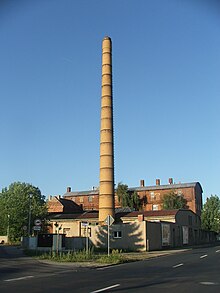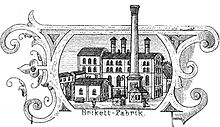Briquette factory in Hohenzollern
The “Hohenzollern” briquette factory was located in the northeast of the southern Brandenburg spa town of Bad Liebenwerda . It was created from 1889 to 1890 under the direction of the entrepreneur Carl Schwabach, who is also considered one of the founders of the regional lignite industry.
The structure and arrangement of the buildings still preserved resembled those of the briquette factory in Beuteritz, a few kilometers away . The factory went into operation in May 1890. It was filled with lignite from the Rothstein underground pit "Daniel" via an approximately 6.5-kilometer-long cable car that was powered by a 23 hp steam engine.
As it turned out a short time later, this lignite field was far too small for the operation that was being built in Liebenwerda and the company soon ran into financial difficulties. In addition, the long haul of the coal to the factory caused further difficulties, especially in winter, and the company eventually went bankrupt. The operation of this factory was stopped after a relatively short time in 1899. In addition to numerous creditors in the region, Schwabach also lost the capital invested in the project. After further setbacks, such as the closure of an underground mine in Maasdorf and the loss of his entire fortune, he died completely impoverished in Luckau in 1908 .
After 1900 an oven factory was located in the buildings of the colliery, which was later followed by a ceramic workshop.
Since a Lidl supermarket from Liebenwerdaer Waldstrasse was moving to the site of the former briquette factory and the company did not want to invest in the old building, the listed buildings were threatened with demolition. The construction of a 790 square meter supermarket was supposed to start here in 2010. The demolition work finally began in late October 2010. The 36 meter high chimney was blown up on November 19, 2010.
On August 15, 2011, the newly completed Lidl supermarket was opened on the property on Dresdner Strasse. At the same time, as a reminder of the former Hohenzollern oven shack or briquette factory, a kind of “monument”, an old oven door framed with bricks from the demolished building and an information board, was set up and inaugurated at the entrance to the property.
literature
- Author community: coal, wind and water. An energy historical foray through the Elbe-Elsterland . Ed .: Cultural Office of the Elbe-Elster District. Herzberg / Elster 2001, ISBN 3-00-008956-X , p. 47-67 .
- Wolfgang Eckelmann, Michael Ziehlke: Chronicle of the city of Liebenwerda . Ed .: Association for City Marketing and Economy Bad Liebenwerda eV Bad Liebenwerda 2007, p. 102 .
Web links
Individual evidence
- ↑ Frank Hilbert, Doreen Hotzan: “Pro and Contra Ofenbude - Divided opinions on the demolition of the industrial monument in Bad Liebenwerda” in Lausitzer Rundschau, Bad Liebenwerda regional edition, January 23, 2010, p. 13.
- ↑ Will the district approve the demolition of the monument? , Lausitzer Rundschau , Bad Liebenwerda regional edition, July 26, 2008
- ↑ List of monuments of the state of Brandenburg: Elbe-Elster district (PDF) Brandenburg State Office for Monument Preservation and State Archaeological Museum
- ^ Bad Liebenwerda industrial landmark blown up , Lausitzer Rundschau , November 19, 2010 online edition
- ↑ Kurstadt BAD LIEBENWERDA, Der Stadtschreiber: Page 4 - Oven flap reminds of briquette factory, memorial at the shopping market in Dresdner Straße ( Memento from August 6, 2017 in the web archive archive.today )
Coordinates: 51 ° 30 ′ 57.1 ″ N , 13 ° 24 ′ 43.2 ″ E


